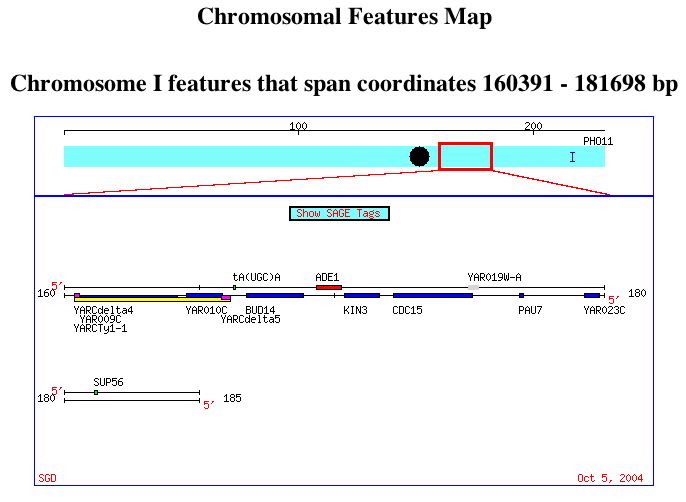
Fig. 1: Chromosomal features map showing the chromosomal location of KIN3 on chromosome I of Saccharomyces cerevisiae. (SGD, 2004; http://db.yeastgenome.org/cgi-bin/ORFMAP/ORFmap?locus=YAR018C.)
My Favorite Yeast Genes
Annotated vs. Non-Annotated
Annotated Gene: KIN3 / YAR018C
Location
KIN3 is located on chromosome I of Saccharomyces cerevisiae,
commonly known as baker's or budding yeast. Below is a map illustrating
the gene's chromosomal location.

Gene Ontology
KIN3 is responsible for encoding a nonessential protein kinase with an unknown cellular role. The molecular function of this gene focuses on protein kinase activity. The biological process of this gene is chromosomal segregation. The cellular for FUN19 has yet to be determined. (SGC, 2004; http://db.yeastgenome.org/cgi-bin/locus.pl?locus=YAR018C.)
Molecular Function: The molecular function of KIN3 lies in protein kinase activity, meaning that this gene is involved in catalyzing the transfer of a phosphate group from a triphosphate, typically ATP, to a protein substrate. KIN3 is one of 54 genes in the Saccharomyces cerevisiae genome that is involved in protein kinase activity. D.G. Jones and J. Rosamond were able to isolate this gene through the use of oligodeoxyribonucleotide probing. (SGD, 2004; http://db.yeastgenome.org/cgi- bin/reference/litGuide.pl?locus=YAR018C.) KIN3 was found to be expressed in cells undergoing mitotic division and was shown to produce a 1400 nucleotide message. The nucleotide message of KIN3 predicts a protein product of 43.4 kDa, containing all of the conserved elements found in known protein kinases but with significant differences in element organization compared to the consensus. The function of the KIN3-encoded protein kinase is not fully understood but it has been proven that the protein kinase is not essential for growth, conjugation or sporulation. (PubMed, 2004; http://www.ncbi.nlm.nih.gov/entrez/query.fcgi?cmd=Retrieve&db =PubMed&dopt=Abstract&list_uids=2199332.)
Biological Process: The biological process of KIN3 involves chromosomal segregation, assisting in the seperation of chromosomes into daughter cells during cell division. KIN3 works along with scNek2 to form a functional homolg to Nek2, responsible for phosphorylating TID3. TID3 is found in both the genome of S. cerevisiae with a structural and functional homolog in Homo sapiens called Hec1. Both of these genes are known to play a critical role in the G2/M phase of the cell cycle. Because KIN3 serves as a homolog to Nek2 this gene can exist with a mutation preventing it from phosphorylating TID3 but not produce a deleterious phenotype in the organism. Although Nek2 exists for both S. cerevisiae and H.sapiens a functional homolog involving KIN3 to human Nek2 has yet to be found. (JBC, 2004; http://www.jbc.org/cgi/content/full/277/51/49408.)
Cellular Component: The cellular component of KIN3 is unknown. By using the information that is known about what other proteins KIN3 works with a hypothesis can be developed as to where this gene works. The previous paragraph outlined that KIN3 works with scNek2 to form a functional homolog of Nek2, which serves to regulate cellular division through the phosphorylation of TID3. Like KIN3, the cellular component of scNek2 is unknown. TID3 can be found in condensed nuclear chromosome kinetochores, the region of each chromosome that appears during mitosis where the chromatids are held together to form an X shape. (SGD, 2004; http://db.yeastgenome.org/cgi-bin/locus.pl?locus=Hec1.) Nek2 is seen to act in multiple parts of the cell and it is believed that more locations are still to be discovered. (JBC, 2004; http://www.jbc.org/cgi/content/full/277/51/49408.) Using this information and the information that can be inferred from the Kyte-Doolittle Hydropathy Plot and BlastP search I would venture to guess that this gene functions in the nucleus. The presence of transmembrane domains, illustrated by the two peaks in the Kyte-Doolittle Hydropathy Plot greater than 1.8, provides evidence that this gene is not restricted by cell or organelle membranes. Genes located in the cytoplasm would not have a need for a transmembrane domain, making it unlikely that it would remain selected for. The information from the BlastP search merely reinforced the close relation KIN3 has with Nek and NIM genes in other species.
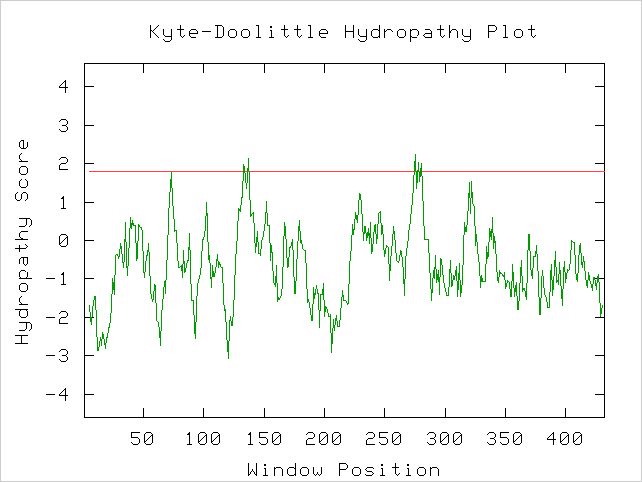
Fig. 2: Kyte-Doolittle Hydropathy Plot of KIN3's amino acid sequence.
The two peaks above 1.8 indicate that this gene possesses transmembrane
domains. (2004; http://occawlonline.pearsoned.com/bookbind/pubbooks/bc_mcampbell_genomics_1/medialib/activities/kd/slrkd.pl.)
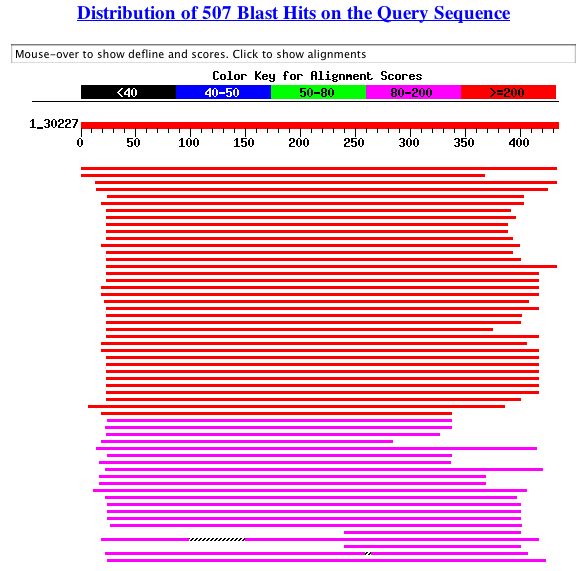
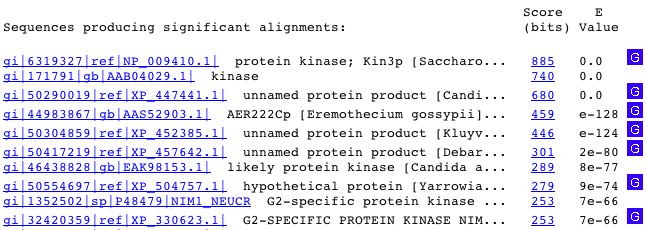
Figs. 3 & 4: BlastP search results using the protein sequence of
KIN3 including the top ten alignments and their E values. (NCBI, 2004;
http://www.ncbi.nlm.nih.gov:80/BLAST/Blast.cgi.)
Links for KIN3:
KIN3
DNA sequence
KIN3
ORF translation
SGC
information page for KIN3
SGC
KIN3 protein information
Non-Annotated Gene: FUN19 / YAL034C
Location
FUN19 is located on chromosome I of Saccharomyces cerevisiae,
commonly known as Baker's Yeast. Below is a map illustrating the
gene's chromosomal location.
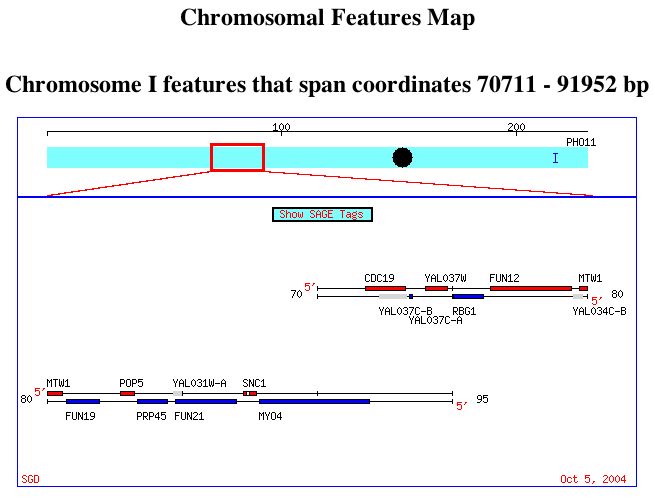
Gene Ontology
Little information is known about FUN19. The Saccharomyces Genome Database, a scientific database that focuses exclusively on molecular biology and genetics of the yeast Saccharomyces cerevisiae, lists the molecular function, biological process, and cellular component of this gene all as unknown. (SGD, 2004; http://db.yeastgenome.org/cgi-bin/locus.pl?locus=FUN19.)
Nucleotide Sequence: Little information could be gathered from the BlastN search of FUN19's DNA sequence. The closest matches were both from the yeast genome. Both of these matches involved a segment of the XV chromosome that contained the TEA1 gene. This gene is responsible for DNA binding involved in transcription in the nucleus. (SGD, 2004; http://db.yeastgenome.org/cgi-bin/locus.pl?locus=TEA1.)While this information does provide a starting point for further investigation of FUN19's role, the evidence is not solid enough prove the gene's molecular function, biological process, or cellular component. Below is the results of the BlastN search with the two matching segments from chromosome XV shown by the pink bars.
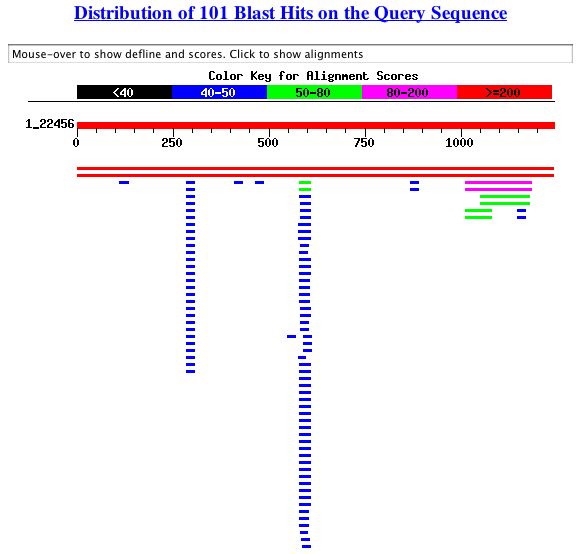

Conserved Domain: The FUN19 possessed two significant alignments for connserved domains. The first is the SWIRM domain, which is a small alpha-helical domain of about 85 amino acid residues. This domain is found in chromosomal proteins and is to be involved in protein-protein interaction. (SDG, 2004; http://www.ncbi.nlm.nih.gov/Structure/cdd/cddsrv.cgi?uid=pfam04433&version=v2.01.) The second domain is for the histone acetyltransferase complex SAGA, which plays a significant role in transcription regulation, both stimulatory and inhibitory. (Penn, 2004; http://repository.upenn.edu/dissertations/AAI9989571/.)


Fig. 7: Conserved domains found in the amino acid sequence of FUN19.
(NCBI, 2004; http://www.ncbi.nlm.nih.gov/Structure/cdd/wrpsb.cgi?RID=1097111248-21408-6495474695.BLASTQ4.)
Kyte-Doolittle Hydropathy Plot: This graph provides evidence as to whether or not the protein produced by FUN19 has any transmembrane domains. Since there are no peaks greater than 1.8 it can be determined that this protein can act within or pass through a membrane without assistance. Due to the lack of any transmembrane domains and the majority of the graph under zero, this protein most likely acts in the cytoplasm or within the hydrophilic region of some organelle of the yeast cell.
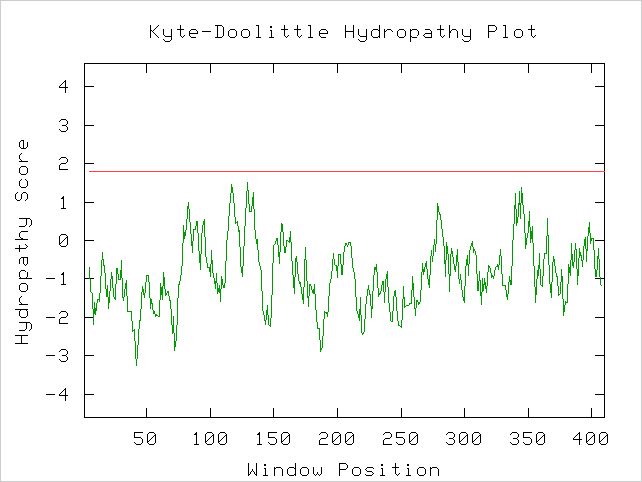
BlastP: The results from the BlastP search of the amino acid sequence of FUN19 did not reveal any new information. The closest match was a hypothetical ORF that also possessed the SWIRM domain that was discussed in the conserved domain section. Many of the other matches were for unknown protein products from different species of fungi, none of which had known functions.
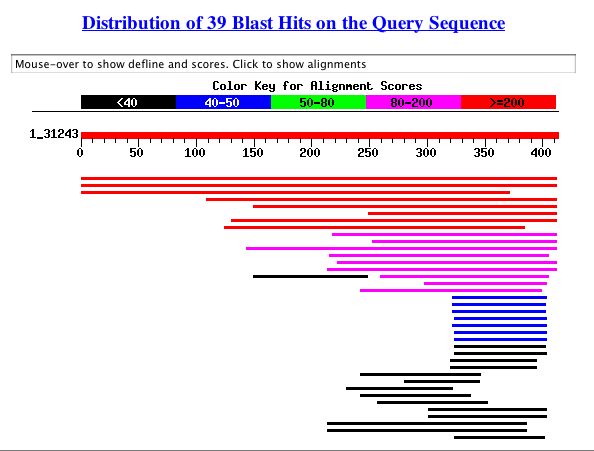
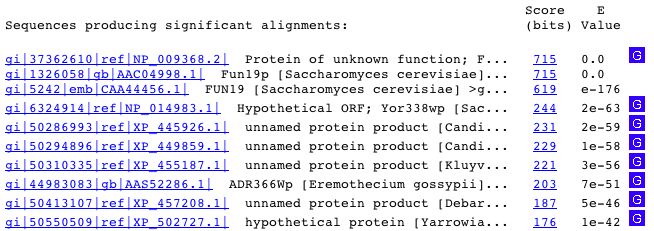
Mutant Information: The table below shows the effect removing FUN19 from yeast has on its phenotype. Based on the fact that the mutant was still viable it can be concluded that FUN19 is not an essential gene, that it does not have to be present for yeast to survive. As a result it is possible that this gene forms a protein that can act as a functional homolog.
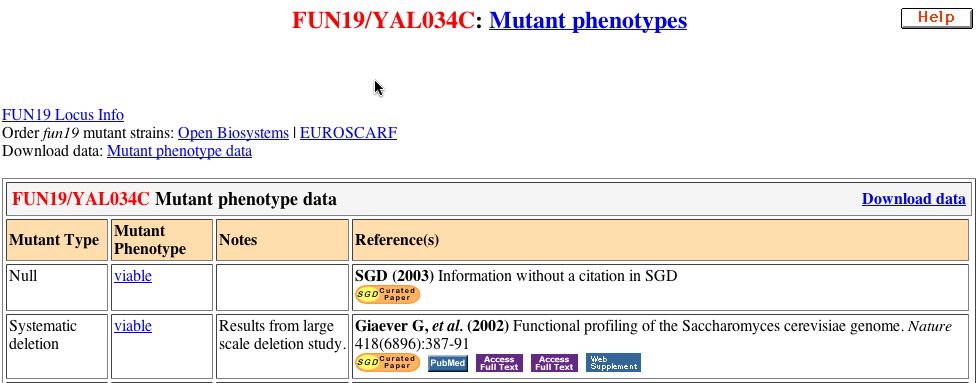
Conclusions of FUN19's role in S.cerevisiae: Judging on
the information that was collected my hypothesis for the function of FUN19
is that this gene is involved in protein-protein interaction taking place
in the cytoplasm. Although the protein produced by FUN19 seems to have
a close relation to proteins involved in transcription because it lacks
a transmembrane domain it is unlikely that the protein operates in the
nucleus. Perhaps this protein is responsible for activating other proteins
which can in turn activate transcription. The role that this gene fills
is either a supporting role or one of minor importance based on the mutant
information that was gathered.
Links for FUN19:
FUN19
DNA sequence
FUN19
ORF translation
SGC
information page for FUN19
SGC
FUN19 protein information
References
Kyte-Doolittle Hydropathy Plot. 2004. <http://occawlonline.pearsoned.com/bookbind/pubbooks/bc_mcampbell_genomics_1/medialib/activities/kd/kyte-doolittle.htm> Accessed 8 October 2004.
NCBI. 2004. <http://www.ncbi.nlm.nih.gov/> Accessed 8 October 2004.
Saccharomyces Genome Database. 2004. <http://www.yeastgenome.org/>
Accessed 8 October 2004.